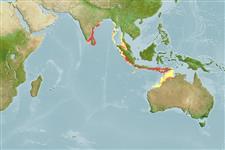Elasmobranchii (tubarões e raias) (sharks and rays) >
Squaliformes (Sleeper and dogfish sharks) >
Squalidae (Dogfish sharks)
Etymology: Squalus: Genus name from Latin 'squalus' meaning shark (Ref. 6885, 27436).
More on authors: White, Last & Yearsley.
Environment: milieu / climate zone / depth range / distribution range
Ecologia
marinhas bentopelágico; intervalo de profundidade 1 - 100 m (Ref. 58445). Tropical
Eastern Indian Ocean: Indonesia.
Length at first maturity / Tamanho / Peso / Idade
Maturity: Lm ?, range 43 - ? cm
Max length : 52.2 cm TL macho/indeterminado; (Ref. 58445); 78.0 cm TL (female)
Descrição breve
Morfologia | Morfometria
This species is distinguished by the following set of characters: slender body of moderate size, depth 9-10.6% TL; relatively narrow and very short snout, horizontal prenarial length is 8.4-9.1% TL; large eyes, length 5.1-5.6% TL; secondary lobe of anterior nasal flap is well developed; small dorsal fins that are strongly raked; first dorsal-fin spine is moderate, broad-based while the second dorsal-fin spine is moderate, robust and broad-based; weakly falcate pectoral fin in adults its inner margin relatively short, 6.9-7.8% TL; caudal fin with a short, broad caudal bar, enlarged upper caudal blotch and the fringe is located distally on lobe in juveniles; flank denticles are broadly unicuspidate to weakly tricuspidate; monospondylous centra 35-38, precaudal centra 72-76, total centra 96-100 (Ref. 58445).
Apparently occurs on or near the bottom of upper continental and insular slopes, but depth distribution is undetermined; probably on shallower water than its congeners. Presumably feeds on small fishes, cephalopods and crustaceans. Viviparous, with yolk-sac dependency. Gives birth to 3 -10 pups, but gestation period is unknown. Males mature at about 43 cm TL and females by 61 cm TL; with largest embryo measured at 18 cm. The species is a very common catch component fo the demersal longline fishery in deepwater areas in eastern Indonesia. It is caught for its meat, fins and liver oil (Ref. 58042).
Life cycle and mating behavior
Maturidade | Reprodução | Desova | Ovos | Fecundidade | Larvas
Distinct pairing with embrace (Ref. 205).
White, W.T., P.R. Last and G.K. Yearsley, 2007. Squalus hemipinnis sp. Nov., a new short-snout spurdog from eastern Indonesia. pp. 101-108. In P.R. Last, W.T. White and J.J. Pogonoski Descriptions of new dogfishes of the genus Squalus (Squaloidea: Squalidae). CSIRO Marine and Atmospheric Research Paper No. 014. 130 pp. (Ref. 58445)
Categoria na Lista Vermelha da IUCN (Ref. 130435)
Ameaça para o homem
Harmless
Utilização humana
Mais informação
Idade/TamanhoCrescimentoComprimento-pesoComprimento-comprimentoFrequência de comprimentoMorfometriaMorfologiaLarvasDinâmica larvarRecrutamentoAbundânciaBRUVS
ReferênciasAquaculturaPerfil para aquaculturaEstirpesGenéticaElectrophoresesHereditariedadeDoençasProcessamentoNutrientsMass conversion
ColaboradoresFotografiasStamps, Coins Misc.SonsCiguateraVelocidadeTipo de nataçãoÁrea branquialOutras referênciasCérebrosVisão
Ferramentas
Relatórios especiais
Descarregue XML
Fontes da internet
Estimates based on models
Preferred temperature (Ref.
123201): 25.6 - 28.7, mean 28.3 °C (based on 20 cells).
Phylogenetic diversity index (Ref.
82804): PD
50 = 0.5000 [Uniqueness, from 0.5 = low to 2.0 = high].
Bayesian length-weight: a=0.00339 (0.00162 - 0.00707), b=3.10 (2.93 - 3.27), in cm total length, based on LWR estimates for this Genus-body shape (Ref.
93245).
Nível Trófico (Ref.
69278): 4.3 ±0.3 se; based on size and trophs of closest relatives
Resiliência (Ref.
120179): Baixo, tempo mínimo de duplicação da população 4,5 - 14 anos (Preliminary K or Fecundity.).
Fishing Vulnerability (Ref.
59153): Moderate to high vulnerability (51 of 100).
